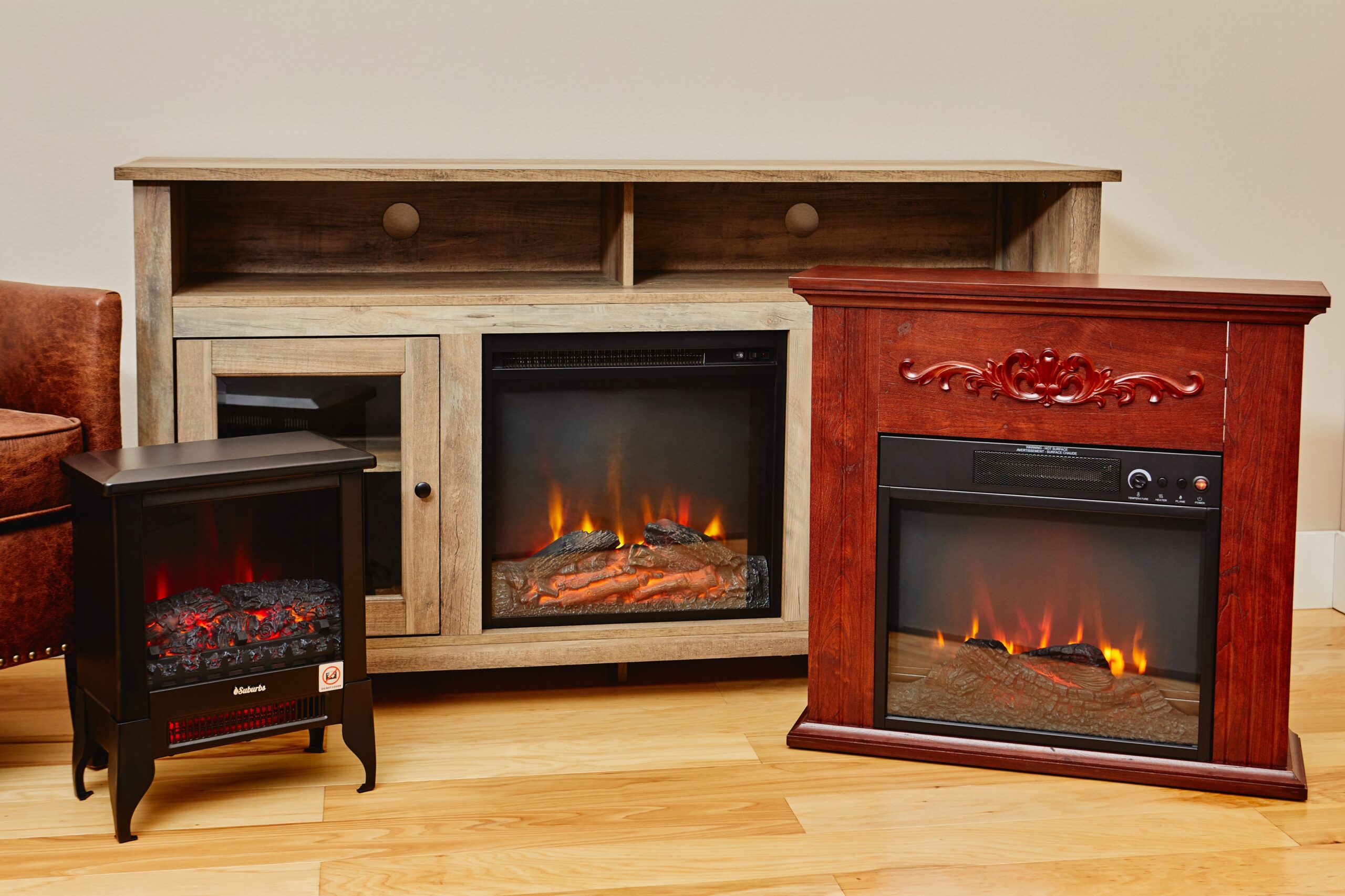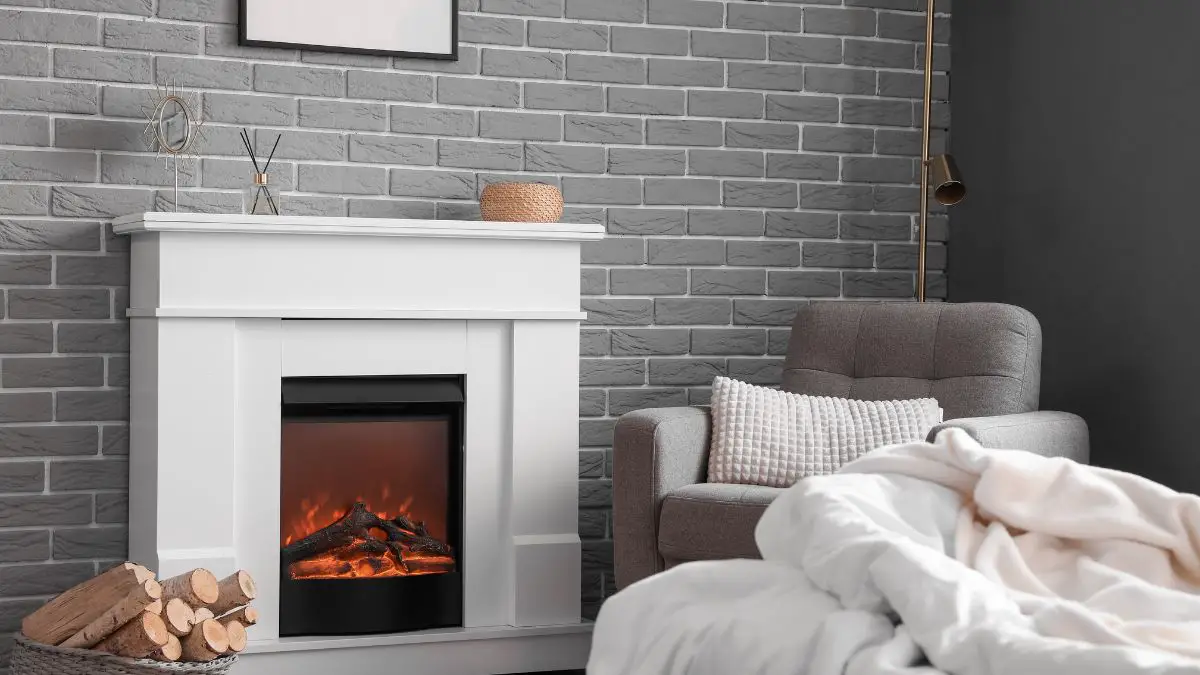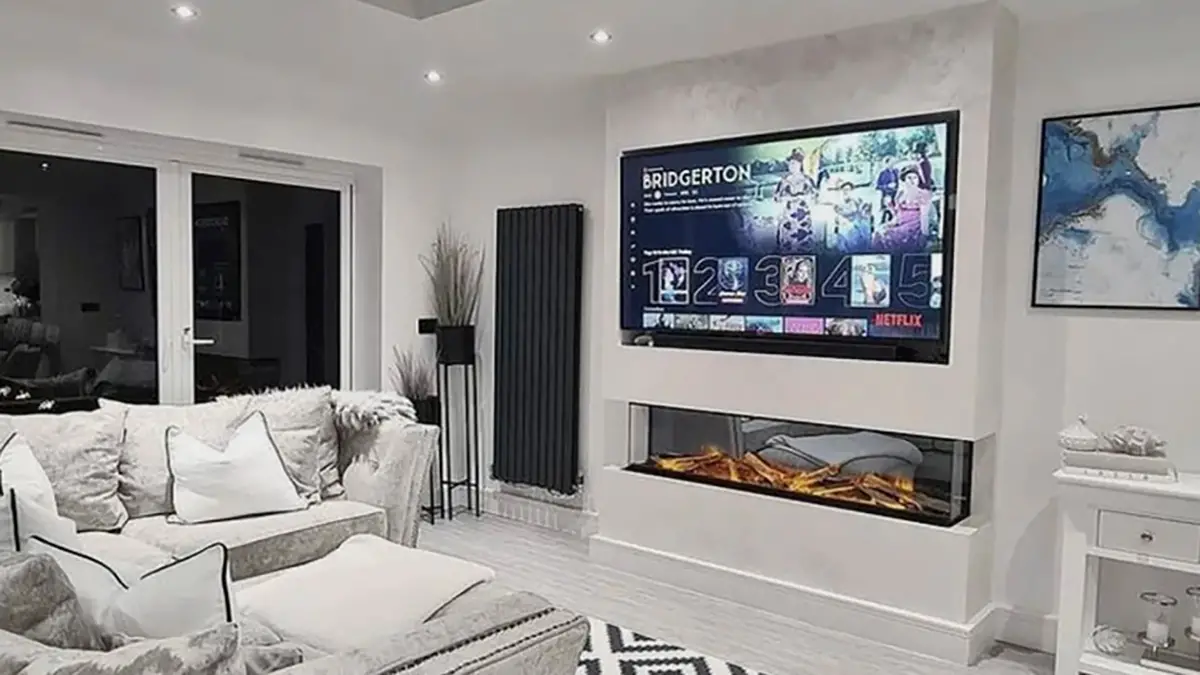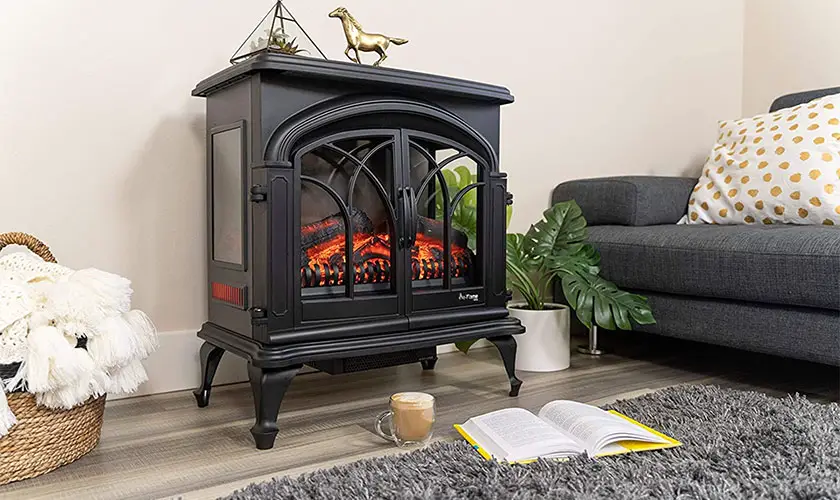Imagine the warmth and ambiance of a crackling fire on a cold winter’s night. Now, picture this without the hassle of chopping wood, cleaning ashes, or worrying about sparks. Welcome to the world of fireplaces powered by electricity!
An electric fireplace is a modern, convenient alternative to traditional fireplaces. It provides the warmth and ambiance of a real fire without wood or venting. However, it’s important to note that electric fireplaces are easy to install, cost-effective, energy-efficient, and safe, but they have a few drawbacks.
Electric fireplaces have revolutionized the concept of fireplaces in our homes. They offer the charm and warmth of a traditional fireplace without the mess and maintenance. But, like any product, they come with their own set of advantages and disadvantages.
Understanding the pros and cons of electric fireplaces is crucial. Why? Because it helps you make an informed decision. It allows you to weigh the benefits against the drawbacks and determine if an electric fireplace fits your home and lifestyle.

What is an Electric Fireplace?
Imagine a fireplace that doesn’t require wood, doesn’t produce smoke, and can be turned on with the flick of a switch. That’s an electric fireplace for you. An electric fireplace is a modern alternative to traditional wood and gas fireplaces. It’s a heating appliance replicating the traditional fireplace burning coal, wood, or natural gas.
Electric fireplaces draw in cool air, heat it internally using a heating coil, and gently force the warmed air back into the room by a fan. They produce a flame effect that mimics the look of a real fireplace. The best part? For a year-round ambiance, you can enjoy the flame effect, with or without the heat.
Here’s what makes electric fireplaces stand out:
- No Real Flame: Electric fireplaces create a lifelike flame without the dangers of a real fire.
- Plug and Play: You only need a standard electrical outlet for an electric fireplace.
- No Venting Required: Since they don’t produce smoke or emissions, electric fireplaces don’t require a chimney or vent.
In essence, an electric fireplace offers the charm and warmth of a traditional fireplace without the hassle of maintenance and cleanup. It’s a stylish, practical, and energy-efficient addition to your home. Whether you’re looking for a heating solution or a decorative element, a cozy fireplace could be the perfect fit.
Summary
An electric fireplace is a modern alternative to traditional wood and gas fireplaces, providing the charm and warmth of a real fire without the need for wood or venting. It operates by heating cool air internally and releasing it back into the room, creating a realistic flame effect.
Pros of Electric Fireplaces
Easy Installation
One of the most significant advantages of electric fireplaces is their ease of installation. You don’t need a chimney, vent, or gas line. You simply choose your preferred style, find the perfect spot, plug it into an electrical outlet, and voila! You have a cozy, warm fireplace.
Whether considering a wall-mounted electric fireplace or a freestanding electric stove fireplace, the installation process is straightforward and hassle-free. You can even opt for an electric fireplace insert to convert a traditional fireplace.
Cost-Effective
When it comes to cost, electric fireplaces shine. They are generally less expensive than their wood or gas counterparts, both in terms of upfront cost and maintenance. There’s no need for expensive chimney cleaning or maintenance, and you won’t have to buy firewood or pay for gas.
Moreover, most electric fireplaces allow you to use the flame effect without heat. So you can enjoy the ambiance of a crackling fire without cranking up your heating bill.
Energy Efficient
Electric fireplaces are champions of energy efficiency. They convert all their electricity into heat, meaning no energy is wasted. This efficiency can lower energy bills, making electric fireplaces a smart choice for eco-conscious homeowners.
In addition, the heat from an electric fireplace is contained within the room, unlike traditional fireplaces, which can lose up to 50% of their heat up the chimney. This means you get more bang for your buck with an electric fireplace.
Safe to Use
Safety is paramount in heating appliances, and electric fireplaces excel in this area. They don’t produce real flames, so there’s no risk of sparks flying out and starting a fire. The glass front remains cool, protecting children and pets from burns.
Summary
Electric fireplaces offer a host of benefits. They’re easy to install, cost-effective, energy-efficient, and safe to use. Whether you’re looking for a primary heat source or a decorative addition to your home, an electric fireplace could be the perfect solution.
Cons of Electric Fireplaces
Less Realistic Flame
While electric fireplaces offer a cozy ambiance, it’s important to note that the flames they produce are merely simulations. Despite advancements in technology that have led to incredibly lifelike flame effects, they still don’t quite match the allure of a real, crackling fire.
The flames in an electric fireplace are generated by LED lights, which, while beautiful, lack the unpredictable movement and glow of a real fire. For some, this lack of realism can be a drawback, especially if you’re after the traditional fireplace experience.
Dependent on Electricity
As the name suggests, electric fireplaces rely entirely on electricity. This means that in the event of a power outage, your fireplace will be out of commission. Unlike wood-burning or gas fireplaces, which can provide heat even during a power cut, electric fireplaces leave you without a heat source when needed.
Furthermore, if you live in an area where electricity is expensive, the running operating costs of an electric fireplace might add up, especially if you’re using it as a primary heat source.
Limited Heat Output
While electric fireplaces are excellent for providing supplemental heat, they may not be sufficient as a primary heat source in colder climates or larger homes. Most electric fireplaces are designed to heat a specific area, usually around 400 square feet.
While they’re perfect for heating a single room or a small apartment, they might struggle to heat larger spaces effectively. If you’re looking for a fireplace to heat your entire home, you might need to consider other options.
Lack of Authenticity
For some people, nothing can replace the sensory experience of a real fire—the sound of crackling wood, the smell of smoke, and the warmth of the actual flame. In this respect, electric fireplaces can’t compete.
While they offer a visually pleasing alternative, they lack the authenticity that some fireplace enthusiasts crave. There’s no real fire, no real wood, and no real smoke. For some, an electric fireplace might feel more like a nice piece of decor rather than a true fireplace.
Summary
While electric fireplaces have many advantages, they also have a few drawbacks. They offer less realistic flames, are dependent on electricity, have limited heat output, and lack the authenticity of traditional fireplaces. It’s important to consider these factors when deciding whether an electric fireplace is the right choice for you.
For more in-depth information, you can check the following related article: Electric Fireplace Pros and Cons (11 Things You Should Know)

Comparing Electric Fireplaces to Other Types
When choosing a fireplace for your home, it’s essential to consider all your options. Let’s take a moment to compare electric fireplaces with their gas and wood-burning counterparts.
Electric vs Gas Fireplaces
Gas fireplaces, like electric ones, offer the convenience of instant heat at the flick of a switch. They produce real flames and can heat a room quickly. However, they require a gas line, which can limit where you can install them. They also need venting to expel the combustion by-products, which can make electric fireplace installations more complex and costly.
On the other hand, fireplaces powered by electricity don’t require venting, allowing you to install them anywhere with an electrical outlet. They’re also generally safer, as they don’t produce any harmful gases.
Electric vs Wood-Burning Fireplaces
Wood-burning fireplaces offer a traditional and rustic experience. The crackling sounds, the smell of burning wood, and the radiant heat provide an ambiance that electric fireplaces can’t replicate. However, they require much maintenance, from chimney cleaning to ash removal. They also need a steady supply of firewood, which can be expensive and requires storage space.
Electric fireplaces, on the other hand, require minimal maintenance. There’s no ash to clean up, no chimney to sweep, and no need to buy or store firewood. They offer a clean, fuss-free alternative to the traditional wood-burning fireplace.
Each type of fireplace has its own set of advantages and disadvantages. Gas fireplaces offer real flames and quick heat but require a gas line and venting. Wood-burning fireplaces provide a traditional experience but require a lot of maintenance. Fireplaces powered by electricity are easy to install and maintain, but they don’t offer the exact authenticity of real fireplaces.
Your choice will depend on your specific needs, preferences, and circumstances. Whether you value convenience, authenticity, or a balance of both, there’s a fireplace out there that’s perfect for you.

Choosing the Right Electric Fireplace
Selecting the perfect electric fireplace for your home involves more than picking a style you like. Here are some key factors to consider:
Size and Location
Consider where you want to place your fireplace. Measure the space to ensure the model you choose fits perfectly. Remember, fireplaces powered by electricity come in various forms, including wall-mounted electric units, freestanding models, and fireplace inserts.
Heating Capacity
Think about the size of the room where you’ll place the fireplace. Most electric fireplace models are designed to heat a room of around 400 square feet. If your room is larger, you might need a model with a higher heating capacity.
Style and Design
Electric fireplaces come in a variety of styles, from traditional to modern. Choose a design that complements your home decor. Whether you prefer a sleek, contemporary look or a cozy, rustic vibe, there’s an electric fireplace to match your style.
Features
Look for features that enhance convenience and functionality in your electric fireplace unit. These might include a remote control, adjustable heat settings, or a timer function.
Choosing the right electric fireplace involves careful consideration of your space heaters, central heating needs, style preferences, and desired features. With these factors in mind, you’re well on your way to finding the perfect electric fireplace for your home.
Summary
To choose the ideal electric type of fireplace for your home, consider factors such as size and location, heating capacity, style and design, and desired features. By taking these aspects into account, you can find the perfect electric fireplace that fits your space, matches your style, and offers the desired functionality for a cozy and inviting ambiance in your home.
Pros and Cons of Electric Fireplaces FAQs
Navigating the world of fireplaces powered by electricity can bring up a lot of questions. Here are answers to some of the most common queries:
What are the disadvantages of an electric fireplace?
While electric fireplaces offer convenience and safety, there are some drawbacks to consider such as potentially lower heat output, limited ambiance, energy consumption, reliance on electricity, and installation limitations.
Is it worth getting an electric fireplace?
Yes, getting an electric fireplace can be worth it for many people. They offer numerous benefits such as convenience, safety, easy installation, and various design options.
Do electric fireplaces use a lot of electricity?
No, electric fireplaces are generally energy-efficient and do not consume a significant amount of electricity.
Do electric fireplaces need to be vented?
No, electric fireplaces do not require venting because they do not produce any smoke or emissions.
Can an electric fireplace heat a room?
Absolutely! Electric fireplaces are designed to provide supplemental heat for a room. Most models can comfortably heat a room of around 400 square feet. However, they may not be sufficient as the primary heat source in larger spaces or colder climates.
Conclusion
Navigating the world of electric fireplaces, considering factors such as carbon footprint and carbon monoxide poisoning, can seem daunting. Still, armed with the right knowledge, you’re well-equipped to make an informed decision.
Remember, electric fireplaces offer a host of benefits. They’re easy to install, cost-effective, energy-efficient, and safe. They provide the warmth and ambiance of a traditional fireplace without the hassle of chopping wood or cleaning ashes.
However, they also have their drawbacks. The flames are less realistic, dependent on electricity and a dedicated circuit, their heat output might not be sufficient for larger spaces, and they lack the authenticity of a real fire.
The choice comes down to your personal preferences and needs. If you value convenience, safety, and energy efficiency, an electric fireplace could be a fantastic addition to your home. But if you’re after the sensory experience of a real fire, you might want to consider other options.






